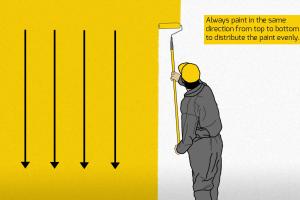The Complete Guide to Wall Painting: Step-by-Step Techniques for a Flawless Finish

-
Quick Links:
- 1. Introduction to Wall Painting
- 2. Tools and Materials Needed
- 3. Preparing the Room
- 4. Preparing the Walls
- 5. Choosing the Right Paint
- 6. Painting Techniques
- 7. Finishing Touches
- 8. Common Mistakes to Avoid
- 9. Case Studies and Real-World Examples
- 10. FAQs
1. Introduction to Wall Painting
Painting a wall can transform a space, making it feel fresh and inviting. Whether you're redecorating your home or preparing a property for sale, understanding the art of wall painting is essential. In this guide, we will provide you with a detailed, step-by-step approach to painting walls, ensuring you achieve a professional finish every time.
2. Tools and Materials Needed
Before you start your painting project, gather the necessary tools and materials:
- Paint (latex or oil-based)
- Paint rollers and brushes
- Paint tray
- Drop cloths or plastic sheeting
- Masking tape
- Sandpaper (fine and medium grit)
- Primer (if needed)
- Ladder or step stool
- Paint can opener
- Rags for cleaning
3. Preparing the Room
Preparation is key to a successful painting project. Here’s how to prepare the room:
- Remove furniture or move it to the center and cover with drop cloths.
- Remove outlet covers and any wall decorations.
- Ensure proper ventilation by opening windows and doors.
- Check the weather if painting outdoors; avoid rainy or humid days.
4. Preparing the Walls
Proper wall preparation is crucial for a smooth application. Follow these steps:
- Clean the walls to remove dust and grease.
- Fill in any holes or cracks with spackle, and sand smooth once dry.
- Apply primer if you are painting over a darker color or on raw drywall.
5. Choosing the Right Paint
Selecting the right paint can significantly impact the final look of your wall. Consider the following:
- Type: Latex paints are easy to clean and dry quickly, while oil-based paints are more durable.
- Finish: Options include matte, eggshell, satin, semi-gloss, and high-gloss. Choose based on the room's function.
- Color: Consider the lighting and mood you want to create.
6. Painting Techniques
Once you have prepared everything, it’s time to paint! Here are the steps:
Step 1: Cut In
Start by using a brush to "cut in" around edges, corners, and trim. This creates a clean line before rolling.
Step 2: Roll the Walls
Using a roller, apply paint in a W pattern for even coverage. Work in sections, overlapping each stroke.
Step 3: Second Coat
After the first coat dries, apply a second coat for a more vibrant finish, following the same rolling technique.
7. Finishing Touches
Once the paint is dry, remove the masking tape, replace outlet covers, and rehang decor. Ensure everything looks tidy.
8. Common Mistakes to Avoid
To achieve the best results, avoid these common pitfalls:
- Skipping wall preparation.
- Using the wrong type of paint.
- Not allowing sufficient drying time between coats.
- Overloading the roller with paint.
9. Case Studies and Real-World Examples
Here are some real-life examples of successful wall painting projects:
- Case Study 1: A small living room transformed from beige to deep blue, enhancing the space’s coziness.
- Case Study 2: A kitchen updated with a bright yellow accent wall, improving the overall ambiance.
10. FAQs
1. How long does it take for paint to dry?
Generally, latex paints dry to the touch in about 1 hour, but it's best to wait 4-6 hours before applying a second coat.
2. Do I need to use primer?
Using primer is recommended when painting over dark colors or bare drywall to ensure better adhesion and coverage.
3. How do I clean paint brushes?
Clean latex paint brushes with soap and water, while oil-based paints require mineral spirits.
4. Can I paint over old paint?
Yes, but ensure the old paint is in good condition. If it's peeling or cracking, it's best to strip it.
5. What should I do if I get paint on trim?
Wipe it off immediately with a damp cloth. If it dries, use a small amount of paint thinner to remove it carefully.
6. How can I avoid roller marks?
Use even pressure while rolling and ensure your roller is well-loaded with paint.
7. Is it safe to paint indoors?
Yes, provided you have proper ventilation. Open windows and use fans to circulate air.
8. How much paint do I need?
Calculate based on the wall area; one gallon typically covers 350-400 square feet.
9. Can I paint over wallpaper?
It’s not recommended, as the wallpaper can bubble or peel. If necessary, remove it first.
10. What’s the best time of year to paint?
Spring and fall are ideal due to moderate temperatures and humidity levels.
Random Reads
- How to replace shut off valves
- How to replace smoke detectors
- How to unblock clogged washing machine drain
- How to make rca cables
- How to make private runescape server
- How to transmit audio with laser pen
- How to maintain dirt gravel drive
- How to maintain your computer
- How to make cmd beep
- How to make chain armor in minecraft